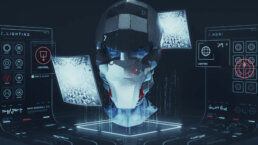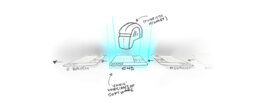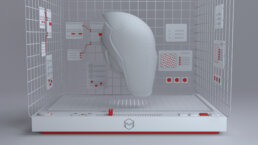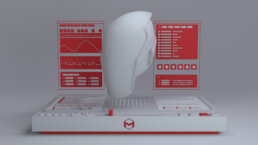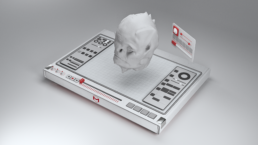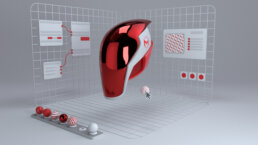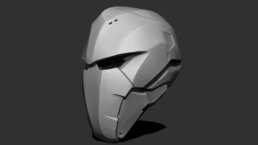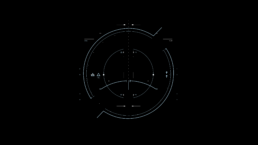01
INTRODUCTION
The team at Maxon asked our team at Perception to design and animate a unique, cinematic video that would highlight the capabilities of the Maxon One toolset. This showcase video would feature a demonstration of ZBrush, Cinema 4D, Red Giant and other Maxon One tools. The video would also premiere alongside the Maxon One product announcements that took place online.
Maxon One Cinematic Toolset Showcase Video
02
A HISTORY OF COLLABORATION
For over a decade, our team has been partnering with Maxon. We have often presented at their conferences, providing insights and education in subjects such as motion graphics, technology and FUI. Most notably, our team provided a comprehensive video series titled ‘The Perception Guide to FUI’ for Cineversity, an extensive training and education resource offered by Maxon. This history of collaboration and our substantial portfolio of high-tech and UI work led Maxon to ask our team to help launch the Maxon One bundle with a promotional video.
INITIAL SKETCHES OF NARRATIVE DIRECTION
Maxon wanted this video to include a very distinct and memorable Perception touch inspired by our futuristic technology work for film sphere and real-world technology. It was always the intention for this showcase to be marked with our signature FUI stamp. Everything in the showcase would be a blend of Maxon One’s capabilities and how Perception’s UI could explore them.
CURSOR ICONOGRAPHY AND COLORING DEVELOPMENT TESTS
Throughout the process, the team at Maxon was incredibly open to our ideas. Since we are frequent users of Maxon One, they understood that our team was among the target audience that they were trying to reach with this promotion. Maxon aided us in the development of our ideas and worked with us to shape and mold them. However, they gave our creative team complete respect and freedom to build the concept, and the entire process was a great continuation of our partnership.
03
A REPRESENTATIVE SHOWCASE
One of the most important aspects of the showcase video was that it couldn’t just look cool. It had to depict the various products of Maxon One and show how they could be used. Since our team uses Maxon’s tools for almost every project we work on, we were able to accurately map out how each tool could be used in unique ways.
First Development Animatic
04
INITIAL CONCEPTS
Our initial concept involved a subject that would be formed, created and detailed by ZBrush, Cinema 4D and other Maxon tools as it moved down a conveyor belt. We explored what this platform could be built from using different look development tests.
INITIAL CONCEPT FRAMES
We tested the look of a light-based table, a science fair-style board and a turntable. We also looked at various sample control panels and methods of representing the UI since we knew the UI would be a crucial aspect of our Perception touch.
Other elements that we explored were how to depict shaders and sculpting tools. Our original concept explored balls, bullets or buttons that could be representative of the desired function based on shape, size and color.
SHADER AND SCULPTING TOOLS DESIGN EXPLORATION
05
EVOLVING THE CONCEPT
Because the video was intended to be recognized as work by Perception, we wanted to include elements of science fiction and decided to make the subject on the conveyor belt an alien with a futuristic helmet. With our subject established, we moved on to figuring out how to expand the character in more extensive and complex ways.
SECOND DEVELOPMENT ANIMATIC
Our Creative Director, Greg Herman, and Senior Art Director, Ryan Close, took the lead on evolving the original idea in a direction that was more refined and sophisticated. What began as a design that included large, blocky shapes and defined buttons started becoming more delicate and detailed.
REFINING THE LOOK OF THE ALIEN AND UI
We guided the video to become more tech savvy and futuristic, using deep colors and intricate UI to fit more with our personal aesthetic and better represent the complexity and power of Maxon One’s abilities. The result was a blend of high-level, elaborate UI and a series of several narratives.
BASE UI DEVELOPMENT
06
A NARRATIVE PIECE
Like everything we create, we wanted the Maxon One piece to be truly cinematic and tell a story. As we were building this video, we realized that we had opportunities to depict more than one narrative involving Maxon One.
At surface level, the video demonstrates the capabilities of Maxon One. But it also tells the story of a being gaining the ability to live, breathe and think. In the beginning, we are sculpting an alien from scratch. Then, as Maxon’s tools are applied, the alien begins gaining sentience. When we zoom in to texture, his eye begins to move and look around. By the end, we understand that this alien has gained sentience and has made the jump to light speed himself.
DEVELOPMENT OF ALIEN HUD DETAILING
While the alien gaining sentience was fun to include, it also paved the way for another important narrative — Maxon One can literally be used to bring characters to life.
Our team used Cinema 4D as the main tool for creating the animation and building key elements to tell the story. ZBrush was used to sculpt the alien’s helmet, and to create the alien itself in collaboration with ZBrush instructor Ian Robinson. We utilized Red Giant’s various complex effects for compositing and the final edit, and rendering was done in Redshift.
ICON AND MODE LOOK REFINEMENT
07
BUILDING THE UI
Since the UI was our notable stamp on this piece, it was imperative that every detail of this futuristic interface stand out and be comprehensive. Each UI element was constructed in Adobe Illustrator. The elements were then brought into Adobe After Effects to animate them. This allowed our team to build purposeful and intricate details. We then brought them into the edit as textures.
UI BREAKDOWN
08
THE IMPORTANCE OF SOUND DESIGN
Another way we elevated this piece was through crafting a custom sound design. Since there are many moving parts and functions being utilized and represented in the showcase, we wanted to ensure that every movement and moment was distinct.
GROUND UI MOTION TEST
Our Creative Director Greg Herman served as the sound designer and engineer for this project, and we began by researching and gathering sound effects that we believed were appropriate for the edit. We would chop them up, slow them down, speed them up and adjust them to match each element. For functions such as a switch turning on or an object pulling away from the camera, we would edit the sound to begin slow and quickly ramp up. The opposite would be applied for a function shutting down.
REFINEMENT OF THE ACTION PANEL UI
There’s a sound for everything in the piece. When something moves, shifts or is operated, there’s a sound to match it. For buttons that are pressed, switches that are activated or elements that move, we picked out perfect and precise sounds for each action. It all comes back to the idea that Maxon One brings the user’s work to life. These sounds and interactions add extra layers of life, dimension and energy that is a nod to Maxon One’s capabilities.
Beyond the more detailed sounds, Greg also constructed a custom score for the video by taking a pre-existing score and augmenting it to the timing and beats of the piece. We sampled and experimented with various scores before landing on something that was upbeat and driving, full of action and energy. To match the new and final score, we updated elements in 3D, adjusted camera movements, made texture changes and animated light speed. These new elements and renders were then integrated into the final edit.
CRAFTING THE UI OF THE DATA PANELS
09
EDITING WITH A FILMMAKING MINDSET
As we built this piece, our team felt that it was much more than just a promotional video. Rather, it was an editorial piece. Throughout the process, we were applying a filmmaking mindset. To build the final edit, we used Adobe Premiere Pro, now applying a filmmaking mindset to the edit itself. By using this program, we could produce a cleaner, sharper edit that made the story a punchy and quick narrative. Every detail mattered and was crucial to show in the edit. We wanted to ensure that when something is clicked on, we can see what it does and how it works. We treated this piece as a film with Maxon One as our filmmaking tools.
PANEL TRANSITION ANIMATION DEVELOPMENT
10
CONCLUSION
It is always incredible to collaborate with the team at Maxon, especially on a cinematic and narrative showcase such as this. Crafting this video was a creative undertaking that challenged us to depict the advanced capabilities of Maxon One in a unique way.
Explore more about the Maxon One bundle here.
